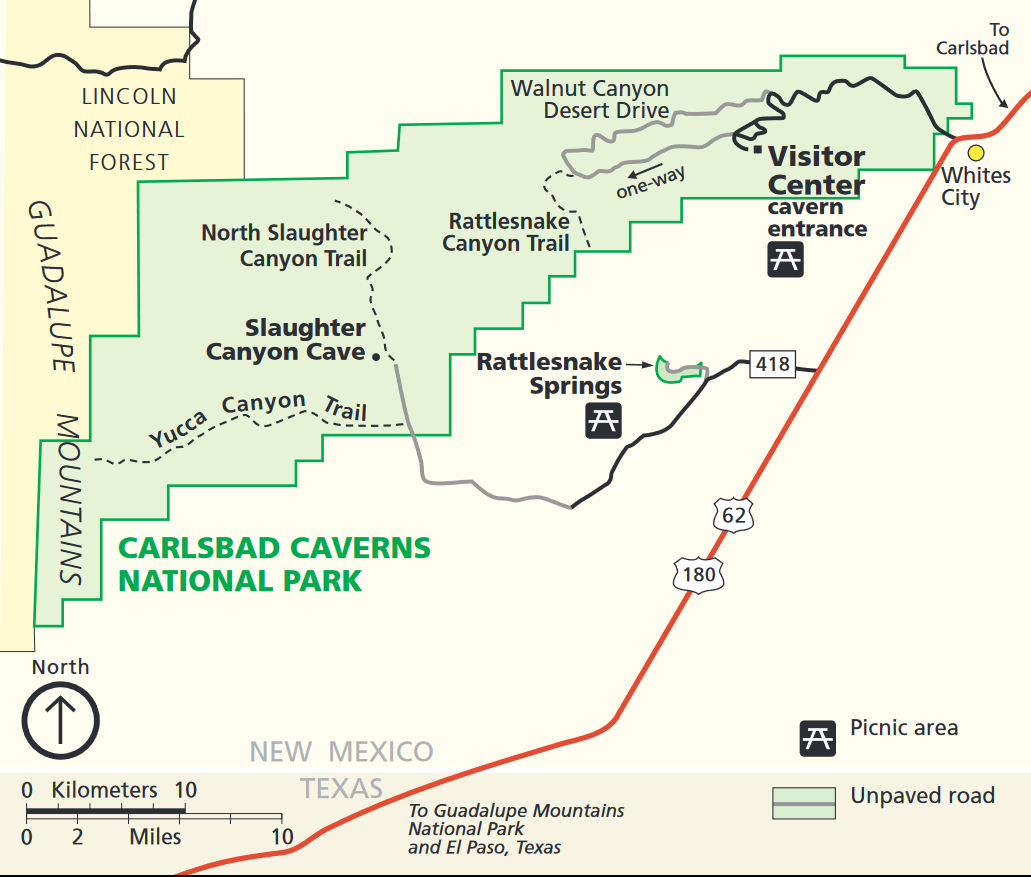Carlsbad Caverns NP--Indian Rock Shelter
Carlsbad Caverns NP--Indian Rock Shelter
Carlsbad, New Mexico 88220
Carlsbad Caverns National Park Official WebsiteCarlsbad Caverns Important Bird Area webpage
Carlsbad Caverns National Park map
About this Location
Indian Rock Shelter is accessed from the Walnut Canyon Nature Trail which is located on the road to the cavern entrance.
About Carlsbad Caverns National Park
See all hotspots at Carlsbad Caverns National Park
The Carlsbad Caverns Natural Entrance has been designated as an Important Bird Area.
Carlsbad Cavern is one of over 300 limestone caves in a fossil reef laid down by an inland sea 250 to 280 million years ago. Twelve to fourteen thousand years ago, American Indians lived in the Guadalupe Mountains; some of their cooking ring sites and pictographs have been found within the present-day boundaries of the park. By the 1500s, Spanish explorers were passing through present-day west Texas and southeastern New Mexico. Spain claimed the southwest until 1821 when Mexico revolted and claimed independence. Mexico, fighting the westward expansionist United States in the late 1840s, lost the southwest to the US. In 1850, New Mexico Territory was created, and for the next 30 years, the cultural conflict between American Indians and the US government continued. Eddy, New Mexico, the future Carlsbad, was established in 1888 and New Mexico became a state in 1912.
The park’s cultural resources represent a long and varied continuum of human use starting in prehistoric times, and illustrating many adaptations to the Chihuahuan Desert environment. Human activities, including prehistoric and historic American Indian occupations, European exploration and settlement, industrial exploitation, commercial and cavern accessibility development, and tourism have left reminders of their presence, and have contributed to the rich and diverse history of the area.
The park has two historic districts on the National Register of Historic Places: the Cavern Historic District and the Rattlesnake Springs Historic District. The park museum, including the park archives, contains approximately one million cultural resource artifacts that are being preserved and protected.
The list of birds that have been observed in the park includes 357 species. This huge list includes species that are year-round residents and nest here, neotropical migrants that nest in the park or pass through on the way to northern breeding grounds, winter residents, and occasional or rare species that wander in and may stay a while.
The park’s common year-round residents include some interesting and colorful species. The Ladder-backed woodpecker, the second-smallest North American woodpecker, is equally at home on a cactus stem or a sotol stalk as on a tree trunk-a useful adaptation when you live in desert shrublands with few trees. It was historically called cactus woodpecker. The cactus wren is another year-round resident that is obviously at home with cacti, building nests in them for breeding as well as for roosting. This is the largest of the nine North American wren species, all of which have been seen in the park and six of which breed here. Rock wrens, black-throated sparrows, and Northern mockingbirds are among the commonly seen year-round residents of the park.
Migratory species are numerous. The park provides some of New Mexico’s prime breeding habitat for three state-threatened birds: Bell’s vireo, gray vireo, and varied bunting. Bell’s vireos nest at Rattlesnake Springs, the park’s wooded riparian area, while gray vireos nest in dry canyons with small desert trees such as oaks and junipers. Varied buntings nest in dry canyons with somewhat larger trees.
Content from Carlsbad Caverns National Park Official Website
